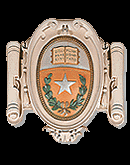| Main Page |
| Information ·Instructor Info ·Class Info ·Acknowledgements ·Dedication ·Bibliography |
| Class Topics ·Ng'amoritung'a ·Nabta ·Petroglyphs ·African Stars ·Borana Calendar ·Sky of Kenya in 300 BC ·The Future |
| Class Research ·Class Emails ·Outside Emails |
| Class Products ·Fiction Stories ·Art Drawings |
| Maps of Africa |
| Other Links |
PetroglyphsPetroglyphs and Ancient ArtsAt the Lokori and the Kalokol Namoratunga sites, rock art was found on several of the pillars. Lynch listed twenty- three symbols that he found in his survey of Namoratunga II. Many of these symbols are the same symbols used by the Turkana people as brands for their livestock. It could be possible that these Turkana symbols are from the same ancestral pool of animal brands as Cushitic and Nilotic speakers in the past, but this would mean that many other peoples would recognize the symbols. Recent inquiries have found that the Masai, Pokot, and Samburu tribes do recognize the symbols, although less of them than the Turkana. The Turkana elders consistently recognized the symbols when about twenty of them (taken in groups of two and three), were asked to identify them when drawn in the sand. They could also draw them in the sand when given the name of the symbol. It is a fact that all rock art can not be directly dated through patination processes, and Namoratunga is no exception. The patination at the Lokori site ranges from the symbols being completely patinated, in the same state as the rest of the rock that they are on, to being completely fresh. This means that the art could have been executed at any time after the pillars were erected. The conflict with the idea of the art being made after the pillars were erected is that art is only found on the male graves and only the builders of the graves would know who is buried where and what gender they are. An explanation for the different levels of patination could be that people recopied the designs on top of the original designs at a time after the graves were erected, or people could have added symbols on the same pillars that had original designs. The latter could be an explanation of the Turkana not recognizing all of the symbols. The art at the Kalokol and Lokori Namoratunga sites is very similar. The art at the Kalokol site is all completely patinated and that rocks used are a harder, different type of rock. Elsewhere in Africa, there is rock art that has astronomical undertones. For instance, in the San Rock paintings of South Africa, there are incisions in the rocks that depict comets or fireballs, and stars. After much analyses though, they are believed to be symbols that represent streaks of light or meteors seen when entering a trance. Other forms of art were found at several sites. For instance, the ancient Egyptian site, Nabta, contained art all over the pottery that was excavated. In wooden bowls and walking sticks, astronomical representations were obvious such as star formations, and crescent shaped moons. Body decorations are found to this day in Africa that represent celestial objects. The women of the Chopi tribe and other tribes in Mozambique incise circles on their foreheads to represent the full moon. Men of the Muyanga clan in Namibia, whose name derives from "the heat of the sun", tattoo their backs with pictures of sun- rays to depict the rising sun, and with lines on their forearms to represent meteors. Women from other tribes in Namibia decorate their lower lips with jewelry such as polished quartz pieces, which they believe to be fallen stars. (M. Hymen) |

